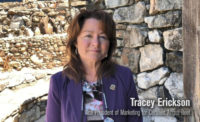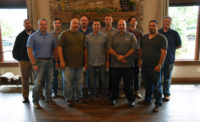The opening reception at this year’s Certified Angus Beef Annual Conference featured the things you might expect: ribeyes, strip steaks and tomahawk chops. There were also some things that you might not expect, like swords, pitchforks, dangling pineapples and fire. Lots and lots of fire. The dinner was designed to do more than just please the taste buds. The flames, the smoke, the smells and sounds of cooking meat — it was a meal designed to appeal to all the senses, and it showed off the creativity of today’s independent chefs.
The annual Certified Angus Beef event took place at the Grove Park Inn in Asheville, N.C., on September 23-25. It brought together people from across the beef supply chain, from producers to processors to distributors to retailers and foodservice professionals. The three-day event included numerous educational sessions about beef trends, as well as a new products showcase by CAB-certified processors. Guest speakers included NFL Hall-of-Famer Morten Andersen and former Blue Angels pilot John Foley. The star of every meal, though, was beef, and the opening reception showed that a good steak and a creative chef are a perfect combination.
In the foodservice world, there are multiple types of restaurants, and multiple needs for meat and poultry processors. The typical restaurant kitchen may have evolved with better and faster cooking equipment, but the needs of the kitchen staff haven’t changed. They need meat products that are of consistent size and quality and lend themselves to quick preparation.
Food concepts, though, are evolving. As consumers increase their knowledge about the food they eat, they are showing an increased appreciation for the cooking process. Chefs, particularly those at independent restaurants, can become stars themselves, thanks to social media and creative menu items. The open kitchen concept gives diners a chance to watch the preparation and makes the kitchen almost a performance area.
Chef Tony Biggs, director of culinary arts for Certified Angus Beef, said that chefs who formerly embraced trends like molecular gastronomy are now going back to cooking’s primal roots — fire.
“It’s all about the show now. It’s about grilling in front of folks, it’s about that fire, it’s about that experience, getting something charred and put down in front of you,” he said.
Chefs Greg and Kristina Gaardbo, owners of Chicago Culinary Kitchen, know a little something about creating a spectacle with meat. The chefs are known for their Scorpion Steak, which was developed during a trip to the Certified Angus Beef culinary center in Wooster, Ohio.
“We were cutting tomahawks, and I had an idea,” Greg explained. “The long bone that sits off of that, it was sitting there, and I wondered if we could filet this steak, open it up and see if it would stand up, so that the bone would look like a stinger. I have a laser at my other business, so I made some pincers and a stinger for the top, and we decorated it.”
The Scorpion Steak was an instant hit, so the Gaardbos developed a sequel, the Scorpion King. That entrée uses three ribeyes and weighs in at 120 ounces of beef.
The Gaardbos’ cooking station at the CAB reception blended spectacle with a high-end eating experience. Bone-in ribeyes and back ribs were cooked over grills, skewered on swords. The ribs were served with their Matador Seasoning, a type of achiote paste used in many traditional Mexican dishes. The ribeyes had a garlic espresso chili rub. Side dishes included roasted vegetables and fireball pineapples. The pineapples had their skin removed and were soaked in cinnamon whiskey, hung by wires over an open flames and roasted, while being occasionally sprayed with more whiskey.
The other cooking stations featured a similar mix of dishes that appealed to the eyes and taste buds. Chef Biggs prepared swinging tomahawk chops – so called because they were cooked on a swinging grill over an open fire. Chef Joshua Moore of Volare Italian Restaurant in Louisville, Ky., skewered 4-ounce steaks onto pitchforks and dipped them into fryers filled with peanut oil. After two minutes they came out perfectly cooked. Chef Shawn Heine of the Prime Cincinnati steakhouse, grilled steaks and lobster tails and also offered one of the most popular dishes of the night: a smoked short rib mac & cheese with a Cheeze-It® topping.
Culinary trends
Along with delighting the attendees, the reception showed that chefs should be thought of as artisans. They’re relentlessly creative and are interested in different cooking methods, new cuts of meat or exotic seasonings. It makes sense, then, that companies who supply protein to them should be just as creative and be unafraid to suggest new ideas or new products.
Before the reception, the chefs gathered to discuss their careers and food trends. All of their restaurants had unique twists that made their menus stand out, whether it was in-house dry-aging programs, limited-quantity specials or locally grown produce.
Chicago Culinary Kitchen, a Texas-style barbecue and craft beef restaurant, is only open on weekends. The restaurant opens at 11:00 a.m. and closes whenever they run out of food — usually about three hours later. Christina says that they have a set menu that is very popular, but they also offer specials that change regularly.
“The one thing about my husband is that he doesn’t like to be contained,” she says of Greg. “He’s gone from Tex-Mex to burgers to other traditional barbecue, like Southern or Asian. Our customers love it, because they can get their traditional BBQ that they love – they know they can count on that – but they also get the specials that keep the concept fresh for everybody and lets him and the rest of our staff experiment in the kitchen.”
Moore says that his family bought a farm outside of Louisville when he started at Volare, and he planted a few tomato plants. He brought the extra tomatoes to the restaurant to give to the regulars, and it proved to be a popular item. Three years later, the Moores have 3 acres set aside for fresh produce, most notably heirloom tomatoes.
“This year we planted 1,300 tomato plants, 60 different varieties, all heirloom. It’s a lot of work, but it’s a lot of fun, and it sets us apart from other restaurants,” he explains. “I tell people we were farm to table before it was cool.”









